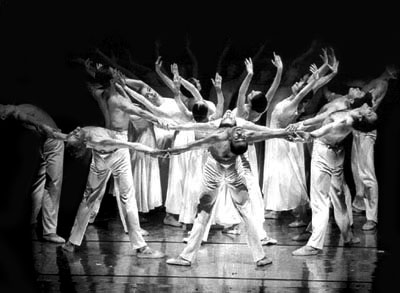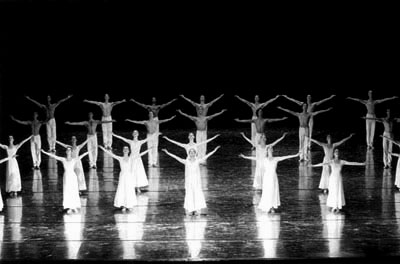PARIS, 6 June 2002
___ After the success of the last two years' visits from
the Leipzig Ballet, the Théâtre de Saint Quentin-en-Yvelines
was completely sold out, with people begging at the door for seats.
Anticipation was at its height for the French premiere of Uwe Scholz'
La Grande Messe, set to Mozart's unfinished score and created for the
company in 1998. Few, however, expected to see a work of such extreme
beauty coupled with undertones of great brutality. Brilliantly conceived,
it was an epic of spectacular intensity which moved, but also upset
and disturbed. ___
___ BY PATRICIA BOCCADORO ___
___ In the first half of the ballet , where Scholz choreographed directly from Mozart's Mass in C Minor, to which he integrated some of the composer's other works, including the Adagio and Fugue in C Minor, the technical level of the company touched perfection. No pointe shoes were to be seen as the women, in fluid long white gowns designed by Scholz, mesmerised with their flowing arm movements. Soloists Roser Munoz and Sibylle Naundorf were particularly poignant. ___
___ Disciplined
and harmonious, the men, in white trousers, partnered with grace and
strength, while the precise geometry of the group choreographies, wonderfully
fluent, was interspersed by lyrical solos and duos of great classical
purity. At one moment, Scholz was actually using his dancers as musical
instruments in an orchestra as they moved in constantly shifting groups
of four with a surge forward or a step for every note. One after another,
the dancers, each with clearly differentiated arm movements, streamed
uninterrupted across the stage in two diagonals, made even more ethereal
and spiritual by the flickering almost heavenly lighting effects, before
they dissolved into the darkness. ___

Leipzig
Ballet in Uwe Scholz' La Grande Messe
Photo: Andreas Birkigt
___ And
then the world exploded. Pandora's box sprang open and chaos and madness
were born. As mirrors and transparent plastic walls descended on stage,
Mozart's score gave place to the dissonant sounds of more contemporary
music : Thomas Jahn, Gyorgy Kurtag and Arvo Pärt, interspersed
with fragments of texts, and the harsh words of Paul Celan, the German/Jewish
poet. Jerky, spasmodic, more theatrical gestures from black-clad figures
replaced the classical and neo-classical style as the universe was turned
upside down. Humorous pieces reflecting the banalities of life tried
unsuccessfully to reduce the tension, and more than one spectator sighed
for that lost white world of glorious music which returned only sporadically,
but which expressed those easy, comfortable emotions so much easier
to live with. ___
___ After Arvo Pärt's Credo, a light-bulb swings down and across the stage, bringing, one dares to believe, a glimmer of hope. Soloist Roser Munoz subsequently confirmed that the solitary dancer, again in black, who ran round and around the stage after it was Scholz himself. The choreographer is no longer merely translating music into movement, but going much further, expressing the suffering of mankind in its quest for the meaning of existence. ___
___ Any
reservations one might have about the work are rather pointless. Very
beautiful ballets to sacred music which gladden and assuage have been
made before, notably John Neumeier's Magnificat, but Scholz' Grand Messe
portrays man as a pawn in the hands of man, as well as being an instrument
of the divine. Black and white, light and shade, optimism and pessimism,
destruction and sublimation are in constant opposition, for the ballet
is a reflection of the irreconcilable, a form of spiritual torture.
It is not only a feast for the eyes. ___

Leipzig
Ballet in Uwe Scholz' La Grande Messe
Photo: Andreas Birkigt
___ During the final minutes of the ballet, as stagehands cleared the scene, the members of the company, removing the last traces of make-up, returned in their everyday clothes. ___
___ "Uwe
wanted us to sit quietly on stage, identify with the audience, and listen
together to the music", the dancers told me afterwards. "Even
tonight, when we were listening to a recording it was very moving for
us, but in Leipzig, we were surrounded by the famous Gewandhaus Orchestra
and a full choir, with a soprano, tenor, and baritone on stage, and
it was a very emotional experience." "I remember him saying
that he simply didn't want to choreograph anything further. The music
alone was enough.", Roser Munoz recalled. ___
___ I
can think of no other classical choreographer today who possesses the
richness of vocabulary, the intense musicality, plus the limitless imagination
to create a work of such scope. ___
___ The
ballet has won two national prizes. The"Grand Prix de la Danse
du Théâtre de Bavière" in 1998, and the "Grand
Prix de la Danse d'Allemagne" in 1999. Scholz' ballets form part
of the repertoire of most of the important European companies with
the exception of Covent Garden and the Paris Opéra Ballet. ___
http://www.culturekiosque.com/dance/reviews/leipzigballet.html